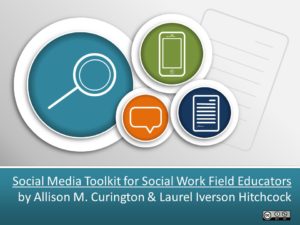Creating an Infographic in a Social Work Course: A Student’s Perspective from Danielle Davis
Last year, Dr. Nathalie P. Jones, from the Department of Social Work at Tarleton State University, wrote a blog post about her experience with a tech-meditated assignment for her social work courses – creating an infographic. She frequently uses technology in her classrooms to help students improve their digital literacy skills, and specifically uses infographics as tools for digital storytelling. As a follow-up to Dr. Jones’ post, I asked one her students, Danielle Davis, to share her thoughts on the assignment, what it was like to create an infographic, and how the knowledge and skills from the assignment might be incorporated in her future role as a social worker. Here are Danielle’s responses to my questions:
What were your initial reaction to the infographic assignment?
I was very hesitant when Dr. Jones initially discussed the infographic assignment in our service learning course. It was the second week of my social work undergraduate program, and I remember wondering if anyone else was as confused as I felt in that moment. I was worried about not being able to complete the assignment according to the grading rubric. I had never created an infographic before, however, I was willing to try. The infographic assignment allowed me the opportunity to be creative and share the information learned about working with vulnerable populations. Being able to use my creative side in an assignment was very appealing.
How did your reaction change over the semester?
Over the semester my reaction to the assignment changed entirely. As we worked on the various steps in the assignment, I started to gain a better understanding about the importance of an infographic and how they can be used. The infographic assignment ended up being my favorite assignment. I enjoyed being able to take a social work issue that mattered, build the infographic that reflected real statistics, and then share the information in Twitter to a large, public audience. I was amazed that people from all over the nation could come together in one place on social media and share information about social work by using infographics.
#SW2018 Visualizing Data: Infographic Assignments across the Social Work Curriculum
This year at the 4th Annual Social Work Distance Education conference, Nathalie Jones of Tarleton State University, Melanie Sage of the University at Buffalo and I presented on the use of infographics in the social work curriculum. This blog post does a few things: 1) it offers an example of infographics as a tool for improving digital literacy; 2) it offers a sample of what a hands-on conference workshop proposal looks like, and; 3) it helps us share our research.
The three of us (Laurel, Nathalie, Melanie) have been working together on polishing our infographic assignments for a few years. In a previous blog post, we offer assignment details and even rubrics you can use to build your assignments if you are a social work educator. We share these in the spirit of service to our profession and to support your work.
We’ve been using infographics as an assignment in our classrooms for several years and have even collected some data across our universities to ask students about the pros and cons. Guess what? The students overwhelmingly love infographic assignments. They appreciate working their creative muscles, like the opportunity to learn a new and transferable skill, and say they’ll use infographics again. Also, the technology can be a little bit frustrating, and some students are uncomfortable with the lack of structure. (We argue that it’s good for students to sometimes get uncomfortable with lack of structure- this experience of managing some ambiguity is an important practice skill, as we know well!)
Here are the slides from the presentation:
Review of Teaching & Learning in Social Work for 2017
 One of my favorite things to do at the end of the year is to read all of the “year-in-review” lists. Books, records, movies, top ten social work journal articles – it doesn’t matter what the list is about, I’ll read it. I am always curious how and why people choose to rank their favorite things from the year. This must be because I find it hard to choose a favorite book or movie when there are so many good options, and how can I exclude anything as a social worker, the profession that loves diversity and strives for inclusion. So for 2017, I offer a list for the Teaching & Learning in Social Work Blog. Not the top-ten blog posts, but the entire year. Here are the numbers:
One of my favorite things to do at the end of the year is to read all of the “year-in-review” lists. Books, records, movies, top ten social work journal articles – it doesn’t matter what the list is about, I’ll read it. I am always curious how and why people choose to rank their favorite things from the year. This must be because I find it hard to choose a favorite book or movie when there are so many good options, and how can I exclude anything as a social worker, the profession that loves diversity and strives for inclusion. So for 2017, I offer a list for the Teaching & Learning in Social Work Blog. Not the top-ten blog posts, but the entire year. Here are the numbers:
Number of Blog Posts in 2017 – My goals was to write or publish at least two posts a month, which happened more months than not:
Total Blog Posts = 25
Highest number of Blog Posts published in one month = 6 (October)
Lowest number of Blog Posts published in one month = 0 (August)
Guest Educator Posts in 2017 – Another goal I have for this blog is to provide a space for others to share their work, particularly work that does not fit into the traditional academic publication venues. For 2017, I am thrilled that eight social work educators wrote seven different blog posts about their scholarship of teaching and learning for the blog. I want to thank all of these authors for sharing their work and for all they do to educate future social workers!
Scholarship Dissemination Posts – My final goal for the year was to write more about my own scholarship by sharing content from conference presentations and any published articles. I published seven posts about national conference presentations with colleagues, and wrote about one article I had published in 2017. Clearly, I am doing more conferencing than publishing.
Below is a list of this year’s post grouped around the topics of assignments, projects, guest educator posts, and conference presentations.
Modeling Social Justice through Innovative, Low-Cost Textbook Options for Social Work Students
Both Dr. Victoria Venable and Dr. Becky Anthony (@becky_anthony) and are assistant professors in the Department of Social Work at Salisbury University. In this blog post, they write about designing and self-publishing a course workbook for a generalist level basic interviewing skills practice course. They also share results from a pilot evaluation the workbook and supplemental materials.
The cost of textbooks is problematic for many students at American colleges and universities. College textbook prices have increased by 82% from 2003 to 2013 (Bureau of Labor Statistics, 2014). This economic injustice causes students to miss out on educational opportunities because they have to prioritize paying for their basic needs over textbooks. According to a 2014 study, over 65% of students reported they did not buy a textbook because the cost was too high (Student PIRGs, 2014). If students are not purchasing the book, they cannot read for class – this revelation caused us to brainstorm creative ways to engage students by lowering the cost of textbooks, in hopes of increasing their reading. As social workers, the NASW Code of Ethics asks us to challenge social injustices. We viewed the price of textbooks as a social injustice and explored options that would allow our students to better participate in their learning experience.
Social Media Toolkit for Social Work Field Educators – Get your Free Copy!
 We are pleased to announce the availability of the Social Media Toolkit for Social Work Field Educators. This toolkit provides Field and other Social Work Educators with tools and resources to help social work students and field instructors assess, develop, and maintain an online identity for professional purposes. There are two parts to the toolkit – an Educator’s Guide and a PowerPoint Slide Deck. The Educator’s Guide provides directions, descriptions, and handouts related to the content of the toolkit while the Slide Deck includes pre-formatted slides with selected content for presenting n the classroom or a workshop. Content in this toolkit can be easily adapted to agency-level continuing education.
We are pleased to announce the availability of the Social Media Toolkit for Social Work Field Educators. This toolkit provides Field and other Social Work Educators with tools and resources to help social work students and field instructors assess, develop, and maintain an online identity for professional purposes. There are two parts to the toolkit – an Educator’s Guide and a PowerPoint Slide Deck. The Educator’s Guide provides directions, descriptions, and handouts related to the content of the toolkit while the Slide Deck includes pre-formatted slides with selected content for presenting n the classroom or a workshop. Content in this toolkit can be easily adapted to agency-level continuing education.
The content of this toolkit is divided into five different topics centered on how to use social media professionally as a social worker:
– Reflecting on Social Media Use in Social Work Practice
– Engaging and Self-Assessment with Social Media
– Professional Practice with Social Media
– Case Studies for Students & Field Educators
– Social Media Learning Activities for Field Education
Teaching Technology-Mediated Practice in a Clinical MSW Program
 Janet Vizina-Roubal, DSW, MSW, is an Associate Professor of Social Work at Ferris State University in the Department of Social Work. In this blog post, she writes about her inspiration for a technology-mediated practice assignment with MSW students. Assignments like this one will be increasingly valuable for social work students preparing to use technology with clients while meeting professional and ethical practice standards such as the NASW Code of Ethics and the NASW, ABSW, CSWE & ACSW Standards for Technology in Social Work Practice. If you have questions about the assignment, you can reach Dr. Vizina-Roubal on Twitter at @jvizina.
Janet Vizina-Roubal, DSW, MSW, is an Associate Professor of Social Work at Ferris State University in the Department of Social Work. In this blog post, she writes about her inspiration for a technology-mediated practice assignment with MSW students. Assignments like this one will be increasingly valuable for social work students preparing to use technology with clients while meeting professional and ethical practice standards such as the NASW Code of Ethics and the NASW, ABSW, CSWE & ACSW Standards for Technology in Social Work Practice. If you have questions about the assignment, you can reach Dr. Vizina-Roubal on Twitter at @jvizina.
I started teaching my first clinical MSW course the fall of 2014 with excitement and nervousness. With almost eight years of clinical experience in school social work and outpatient therapy, I had a great toolbox of practice tips to share with my students. Adding to the excitement was the idea of creating a technology-based assignment where students could learn and practice technology-enhanced therapy skills. Because I had completed and presented research with a colleague about the benefits of using iPhones in child welfare work, I was curious about how I could create a technology-based assignment for MSW social work students.
Clinical MSW social work classes typically rely on a vast amount of face-to-face role-plays, requiring students to play the part of client and social worker. This experiential learning is challenging, however is very effective at teaching students critical clinical skills. I was interested in stretching this experiential learning process into role-plays for a technology-mediated learning environment, with the goal of helping students learn how to engage with clients via technology-based communication tools. Based on this idea, I worked to structure assignments that would allow students to learn how to use technology within clinical social work. As I embarked on this journey, I searched for curricula or assignments on how to teach online therapy along with best practices. Bewildered, I found almost nothing (Cardenas, Serrano, Flores, & De 2008). I did stumble upon research that showed promising findings that online therapy might be as effective as face-to-face therapy (Chester & Glass, 2006; Dowling & Rickwood, 2013; Holmes & Foster, 2012). This finding legitimized my interest in pursuing this course of instruction and compelled me to develop assignments where students gained experience within online therapy; practicing as the client as well as the therapist.






